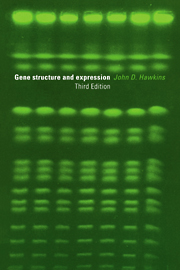Book contents
- Frontmatter
- Contents
- Introduction to the third edition
- Introduction to the second edition
- Introduction to the first edition
- List of abbreviations
- 1 Deoxyribonucleic acid (DNA)
- 2 Ribonucleic acid (RNA)
- 3 Methodology
- 4 Prokaryotic DNA replication and gene expression
- 5 The operon concept
- 6 Eukaryotic gene organisation and replication
- 7 Eukaryotic transcription
- 8 Post-transcriptional processing of RNA
- 9 Oncogenes
- 10 Haemoglobin
- 11 Proteins of the immune system
- 12 Some gene families
- 13 Mitochondrial and chloroplast genomes
- 14 Different and evolving genomes
- Glossary
- Reading lists
- Index
9 - Oncogenes
Published online by Cambridge University Press: 05 June 2012
- Frontmatter
- Contents
- Introduction to the third edition
- Introduction to the second edition
- Introduction to the first edition
- List of abbreviations
- 1 Deoxyribonucleic acid (DNA)
- 2 Ribonucleic acid (RNA)
- 3 Methodology
- 4 Prokaryotic DNA replication and gene expression
- 5 The operon concept
- 6 Eukaryotic gene organisation and replication
- 7 Eukaryotic transcription
- 8 Post-transcriptional processing of RNA
- 9 Oncogenes
- 10 Haemoglobin
- 11 Proteins of the immune system
- 12 Some gene families
- 13 Mitochondrial and chloroplast genomes
- 14 Different and evolving genomes
- Glossary
- Reading lists
- Index
Summary
Retroviruses can be oncogenic, causing cancer
The genomes of retroviruses consist of fairly short (5–9 kbp) strands of RNA containing a very limited number of genes. They are encapsulated in a protein coat that is encoded by two of these genes. The gag gene directs the synthesis of its core protein, and the env gene codes for the glycoprotein spike on the surface of the envelope. They may also carry oncogenes in their genome.
Replication of these viruses is initiated by a reverse transcriptase, encoded by their pol gene. In infected cells the host's RNA polymerase transcribes this gene, producing an mRNA that directs the synthesis of reverse transcriptase on the host's own ribosomes. This enzyme transcribes the viral RNA into a single-stranded DNA molecule to direct the synthesis of a complementary strand of DNA making use of the host's DNA polymerase. This duplex DNA is integrated into the host's genome as a provirus at many sites with duplication of 4–6 bp of the host DNA sequence at each end of the insertion. The provirus can be replicated or transcribed in the usual way, resulting in either the spread of the viral sequence among the host's cells or the production of new virus particles.
The 5′-end of retrovirus RNA contains a cap structure (Chapter 8.2), followed by a short sequence of up to 80 nt (R) that is also found at the 3′-end.
- Type
- Chapter
- Information
- Gene Structure and Expression , pp. 125 - 132Publisher: Cambridge University PressPrint publication year: 1996



